What's New
Displaying results 2781 - 2790 of 4052
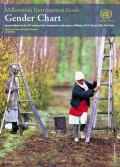
Resource | Publications,
The biennial MDGs Gender Chart depicts the situation of women and girls in developing regions as reflected in a number of indicators that are used to monitor the MDGs. This is a special edition of the MDGs Gender Chart produced by the UN Statistics Division and UN Women, with contributions from other agencies, such as ILO, OECD, UNESCO’s Institute for Statistics and UNAIDS, for 58th session of the Commission on the status of women whose priority theme is Challenges and achievements in the implementation of the Millennium Development Goals for women and girls. It shows that although there has been some progress in a number of the gender dimensions of the Goals, more needs to be done, in every country and at every level, to achieve the MDGs.
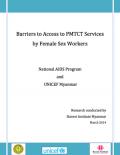
Resource | Publications,
The study was conducted with objectives to explore the barriers to access and utilization of Prevention of Mother-to-Child Transmission (PMTCT) services by pregnant key populations and describe the factors of not accessing PMTCT services. Because of non-availability of pregnant key populations other than FSWs for participation in the study, the study exploration focused only on the FSWs. An exploratory qualitative research design was applied where Round Table Discussions with Key Informants and Individual Depth Interviews (IDIs) with FSWs. During IDIs, short quantitative questions were also posed to this non-random sample to be able to quantify some of the key variables of interest.
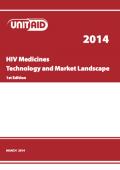
Resource | Publications,
Access to appropriate antiretroviral therapy (ART) is vital to prevent HIV morbidity and mortality, and high ART coverage also promotes HIV prevention by lowering the amount of virus circulating in people within a particular setting or population. The World Health Organization (WHO) released new treatment recommendations in June 2013 that raise the CD4 cell count threshold for ART initiation for most people (from 350 to 500 cells/mL) and expand the number of populations that should receive treatment irrespective of their immune status.
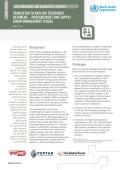
Resource | Publications,
This policy brief provides advice on a phased approach to transitioning to new HIV treatment regimens, as recommended by the World Health Organization (WHO). The target audience includes implementing partners, antiretroviral therapy (ART) programme managers, procurement managers and other relevant parties. The ultimate purpose is to ensure a continuous supply of antiretroviral (ARV) drugs, and ensure rapid and efficient implementation of the new WHO ARV guidelines, with smooth transitioning to new recommended ARV regimens, while reducing the wastage or expiry of products that are no longer recommended.

Resource | Publications,
The World Health Organization (WHO) and the Joint United Nations Programme on HIV/AIDS (UNAIDS) Secretariat jointly organized an annual two-day consultation with pharmaceutical companies and stakeholders to present them with the draft forecasts for the demand of antiretroviral (ARV) drugs in 2013–2016.
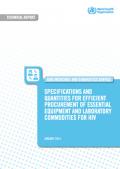
Resource | Publications,
The goal of this report is to provide countries and suppliers with a sense of how the global market for antiretroviral (ARV) medicines in low- and middle-income countries is likely to evolve from 2013 to 2016. The report also aims to provide suppliers with a global forecast of the estimated demand for active pharmaceutical ingredients (APIs) so that they can manage their manufacturing capacity accordingly.
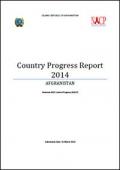
Resource | Publications,
Afghanistan was witness to considerable achievements in the past two years in response to HIV and AIDS which have been reflected in this report. This report will serve as a baseline for reporting on Global AIDS Response Progress Report (GARPR) indicators as a way to track Afghanistan progress and achieving declaration of commitment on HIV and AIDS. This gives the current state of the national response and progress towards achieving national targets for universal access to prevention, treatment, care and support in Afghanistan.
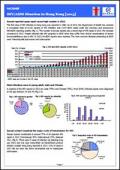
Resource | Fact Sheets,
The first case of HIV infection in Hong Kong was reported in 1984. As of 2013, the Department of Health has received a cumulative total of 6,342 reports of HIV infection and 1,437 AIDS cases under the voluntary and anonymous HIV/AIDS reporting system. The number of annual reports was a record high of 559 cases in 2013, 9% increase compared to 2012. People infected with HIV progress to AIDS when they suffer from clinical complications of severe immunodeficiency due to HIV. In 2013, 84 AIDS reports were received. The most common illnesses presenting at AIDS were Pneumocystis pneumonia and tuberculosis.
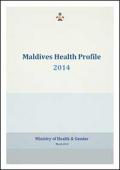
Resource | Publications,
The health care delivery system of Maldives is organized into a four-tier referral system with the island level health facilities referring patients to higher level health facilities in the atolls, regions and to central level depending upon the need and service availability. The government is committed to improving the health services in the country and improving the accessibility of services at the very peripheral levels, which due to the dispersed nature of the population in very small islands exerts diseconomies of scale. Having experienced several fall backs of the divided and corporatized health care delivery initiated in the year 2009, several steps has been taken to bring back the health facilities under the leadership of Ministry of Health and Gender but managed in a decentralized system. To provide financial security and ensure better access to healthcare, all citizens of the Maldives are now covered by a universal health insurance scheme "Aasandha", fully financed by the government.
This booklet intends to give a brief overview of the current health situation in the country including access to services and health resources.
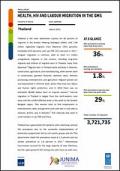
Resource | Publications,
Thailand is the main destination country for 60 percent of migrants in the Greater Mekong Subregion (GMS), with 1.48 million registered migrants from Myanmar (78.6 percent), Cambodia (10.9 percent), and Lao PDR (10.5 percent) in 2011.
Irregular migration is common, with at least 1.5 million unregistered migrants in the country, including long-term migrants and children of migrants born in Thailand, many from Myanmar. Migrant men in Thailand work primarily in fisheries, construction, agriculture, and manufacturing, while women work in construction, garment factories, domestic work, fisheries processing, entertainment, and agriculture. Migrant women are overrepresented in informal work, where they have less labour and human rights protection; and in 2010 there was an estimated 98,000 babies born to migrant women. Internal migration in Thailand is largely from the north-eastern rural areas and the conflict-affected areas in the south to the Greater Bangkok region. Thai women tend to find employment in entertainment, sales, and garment work and men in such jobs as cleaners, drivers, and in factories. Thai nationals also work in small numbers in Lao PDR and China.





